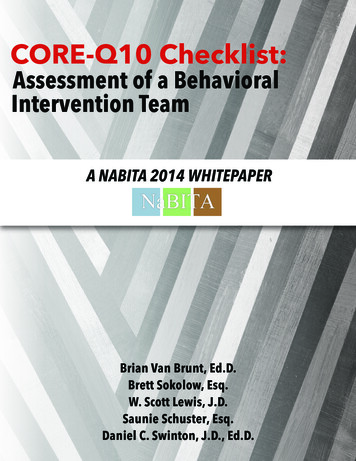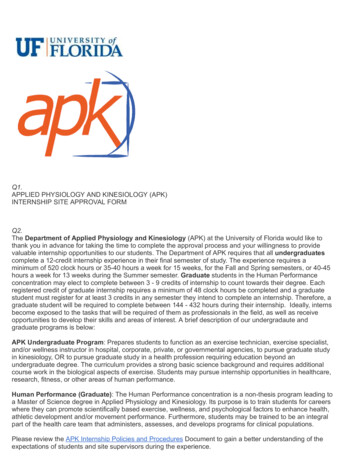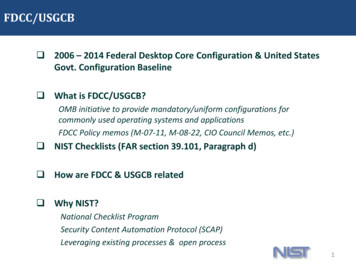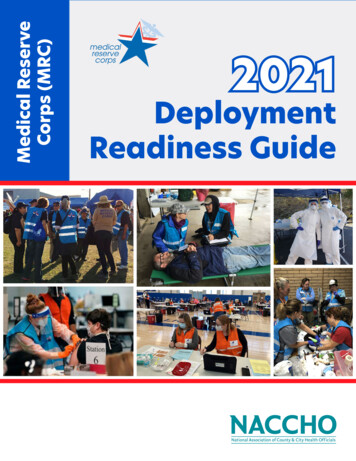
Transcription
CORE-Q10 Checklist:Assessment of a BehavioralIntervention TeamA NABITA 2014 WHITEPAPERBrian Van Brunt, Ed.D.Brett Sokolow, Esq.W. Scott Lewis, J.D.Saunie Schuster, Esq.Daniel C. Swinton, J.D., Ed.D.
This CORE-Q10 Checklist Whitepaperis being shared as a free resourceDownload for free at www.nabita.org NABITA 2014.
CORE-Q10 CHECKLIST:ASSESSMENT OF A BEHAVIORAL INTERVENTION TEAMINTRODUCTIONThe National Behavioral Intervention Team Association (NaBITA) was founded on the goal ofproviding teams clear guidance in developing the most efficacious and efficient approach toaddressing potential crisis events on campus and on preventing the onset or escalation ofviolence. With the introduction of the NaBITA Risk Rubric in 2007, certification trainings forBehavioral Intervention Teams that began in 2010, the publication of dozens of table topscenarios, a large scale survey of BITs from across the country in 2012, and the development ofthe Structured Interview of Violence Risk Assessment (SIVRA-35), NaBITA is now turning its focus toproviding the higher education community with clear guidelines and templates to assess thefunctionality of their teams.The request for an assessment methodology was a frequent theme during the annual NaBITAconference in November 2012. Providing a set of standards for teams to compare against and tostrive towards has long been a discussion between the authors. Following the results of the 2012survey and the development of a three-day BIT Best Practices Certification course, NaBITA’s nextgoal became the development of a set of clear assessment standards and an assessmentmethodology for teams to use in establishing a baseline of their current performance and inidentification of future team improvements.Assessment and program evaluation are well-established constructs and processes in the highereducation and business world. It’s our goal to bring together the best of these theoreticalconstructs to guide the processes of these teams and to provide their communities with anaccurate, accessible, and useful methods to review campus BIT team creation, demographics,mission, record keeping, and analytic decision making processes.The assessment of a BIT provides four major opportunities for the team. First, the assessmentprocess and subsequent results provide the community with evidence concerning how the teamfits with national standards and best practices, as well as how the team’s process keeps thecommunity safe. Second, it’s our belief that good assessment and sharing of results with thedecision makers at your institution creates an opportunity to secure additional funding toleverage support for your campus BIT. Third, assessment provides the BIT with the ability toidentify areas of weakness so that future resources and training opportunities can be focused onimproving those areas. Finally, it’s likely in coming years we will see a more formal set ofexpectations for BITs in terms of team demographics and functionality. The functionalityexpectations may concern formalization of the analytic decision making processes used by BITsand development of practical action steps in the management of at-risk students. NaBITA remainscommitted to providing its members and the larger higher education community with qualityresearch and information for the purpose of helping create safer campus environments. Whilelocks, cameras, and safety programs are helpful in providing a safe environment on collegecampuses, it’s the human intelligence information gathering from those in contact with theindividual in the midst of an aggression escalation that are the best tools campus communitymembers have at their disposal. Behavioral Intervention Teams provide a method for collectingand analyzing information, and for identifying and monitoring persons of concern. It’s our beliefthat all institutions of higher education should develop, train, and support (and assess!) BehavioralIntervention Teams on their campuses.
WHY ASSESS?Four Reasons:1. Improve Community ConfidenceOur campus communities have charged our students of concern, threatassessment, behavioral intervention, and risk assessment teams to identify andmanage at-risk student behavior on our campuses, for the purpose ofpreventing more extreme violence. By following national best practices in thefields of behavioral intervention and threat assessment, this paper provides aframework of comparison for college or university teams. Additionally, thepaper contains key suggestions for teams in development of corecompetencies in ten areas. By addressing each of these core competencies,BITs gain the ability to share clear demographic and operational data thatdemonstrates how the BIT functions and seeks to address potential violenceon campus.The communication of a plan to assess and improve a BIT provides thecommunity with reassurance that the individual team is taking its chargeseriously. It demonstrates team effectiveness in terms of managing cases andin developing clear and actionable plans to move forward. Assessment (andthe dissemination of the assessment results) of the BIT demonstrates acommitment to transparency and to improving team efficacy.2. Secure Increased Funding AllocationWhile perhaps a more pragmatic rationale for assessment, the demonstrationof effectiveness and identification of areas for improvement are two factors thatare required to successfully request increases in funding for a program. Aquality assessment provides a BIT with a well-organized collection of data tobetter form an argument for increases in budget for team leadership, training,staff positions, advertising and marketing expenses, conference attendance,and software platforms. Higher education administrators historically respondwell to funding requests where the requesting department has accurate datathat demonstrates the effectiveness of its operations in line with national trends.A successful budget request demonstrates current efficacy along with theidentification of areas of improvements within the department. While not theonly goal of BIT assessment, the ability to more effectively request increases infunding is aided by a quality assessment.
WHY ASSESS?[cont.]3. Locate Areas for ImprovementThe most pressing argument for BIT assessment is the ability to identify areasof weakness and to develop a clear action plan for moving forward to addresspotential gaps. While not intended as a harsh analysis of a team’s failings,developing an assessment is critical because it helps a team better understandareas of potential shortage or blind spots. NaBITA is often called in to ascertainhow well the team functioned in a situation where violence already occurred.This “Monday morning quarterbacking” is useful in identifying areas ofimprovement for the team to help prevent future lapses or risk.Vastly more proactive and important though, is identifying gaps in a BIT’soperation prior to the occurrence of violence on campus. This white paper isan investment in assisting teams to develop a better preventative focus on theiroperations to get out ahead of possible gaps in team function. Data related tonational BIT formation and operations needs to be in the hands of individualteams in order to assist them in evaluating against national norms and in thelocation of areas for improvement.4. Anticipate Future Assessment RequirementsWhile creating and training leaders in the field of risk and threat assessment inhigher education, NaBITA also keeps an eye focused on the horizon todetermine what might be happening three, five, or even ten years in the future.One reason the authors believe in the importance of BIT assessment is thevery real likelihood of regulation by various legislators in the future. Followingalmost every campus attack, we see state and local legislators faced with thequestion of developing laws and policies to prevent future violence.One of the places to which we hope these legislators will turn is NaBITA as anationally recognized leader in developing training and policy to keep schoolssafe. By developing this set of standards and recommendations for anassessment process, we hope to get out ahead of the curve and take aleadership position within higher education. It is our belief that highereducation professionals are better equipped than legislators to analyze andto create standards for behavioral intervention, risk, and threat assessment.
Ten Core Qualities of a BITThe following are the ten core qualities that are essential to the assessment of behavioralintervention teams. These concepts are pulled from existing surveys (Van Brunt, Sokolow,Lewis, & Schuster, 2012; Gamm, Mardis, & Sullivan, 2011; Campus Safety and SecurityProject, 2009) and research related to BITs (HEMHA, 2012; Van Brunt, 2012; Eells &Rockland-Miller, 2011; Sokolow, Lewis, Manzon, Schuster, Byrnes, & Van Brunt, 2011;Deisinger, Randazzo, O’Neill, & Savage, 2008), as well as the practical expertise of theauthors based on their experience serving on their home campus teams or consultingwith hundreds of BITs across the country.The ten qualities are briefly explored in this whitepaper. In terms of using these ten corequalities in an assessment of BIT, teams are encourage to explore these concepts furtherin the book CORE-Q10 Checklist: Assessment of a Behavioral Intervention Team (BIT)available from k ds6.DataCollecting5.Referral
Ten Core Qualities of a BIT [cont.]Core 1: POLICY Description: Developing a clear sense of policy and procedures for a BIT is anessential task for any institute of higher education. A clear sense of direction andorder of operations separates teams that are simply reactive to crisis events oncampus from those who are thoughtful and strategic in their approach to proactivelyidentifying risk and in following this risk through analysis, intervention, andfollow-up. A quality policy allows for a team to create a starting place for a structuredand well-thought out approach to prevention, intervention, and management whileproviding opportunities for analysis, critique, and improvement to a team’seffectiveness and efficiency.Areas of Assessment: Mission/purpose statement (statement of scope, identifycommunity, phases of operations), and manual.Core 2: TEAM TRAITS Description: There are several core traits that are important to the team. Theseinclude leadership, team size, meeting frequency, and team membership. Teamsshould be strategic and intentional in making decisions about these traits, asopposed to allowing circumstances or outside constituencies to dictate these items.Areas of Assessment: Team size, leadership, meeting frequency, and teammembership.Core 3: SILO COMMUNICATION ADDRESSED Description: One of the key lessons following the 2007 Virginia Tech tragedy wasthe importance of avoiding siloed communication. This business and marketingconcept, known as the “the silo effect” traditionally refers to a lack of coordinationand integration between departments; thus, inadvertently failing to support eachother. In higher education, we understand the silo effect as the isolation amongdepartments that prevents cooperation and sharing of key information useful toaddress potential threats.Areas of Assessment: Silo communication (plan, discussion of counseling limitations, forms and releases, FERPA/HIPAA and confidentiality laws, threat assessmentsharing, obstacle identification).
Ten Core Qualities of a BIT [cont.] Core 4: EDUCATION AND MARKETING Description: A team can be set up and put together like a well-designed sports car,but it won’t be going anywhere without some gas in the tank. The gas here is theinformation we get from across campus. The gas stations are education andmarketing to the community about what kind of behaviors should trigger a phonecall, email, or direct report to a BIT member. To assume the community already hasan understanding of what to report is a dangerous proposition. Many communitiesare confused and scared when it comes to violence on campus, and, despiteefforts to educate the faculty, staff, and student leaders around what behaviorsshould cause concern, the message needs to be continuous and well-targeted(marketed) to the stakeholders.Areas of Assessment: List of behaviors, website, and marketing.Core 5: NURTURING THE REFERRAL SOURCE Description: The referral source is the most essential element of a team. It’s theperson calling 911 to summon the police. It’s people calling for an ambulance andfire truck when they see a fire. In the previous section, we discussed the importanceof teaching the community what to report to the campus BIT. This section isdedicated to the concept of building this relationship between the BIT andcommunity to improve communication.Areas of Assessment: Identifying the stakeholders, training, and communicatingback.Core 6: DATA COLLECTION Description: Once information is reported to the BIT, the team must keep track ofthe data in a way that is secure and easily searchable. Data for data’s sake is aninsufficient goal for a BIT. Data must be collected and stored in a fashion thatprovides access to team members and which provides the ability to analyzepotential patterns that exist beyond the individual team member’s memory. Simplystated, a quality data management system allows for data to be entered and storedin a way that is easily retrievable. Data must also be collected easily fromstakeholders, with efforts to remove any obstacles along the way.Areas of Assessment: Anonymous reporting, multiple reporting avenues,and security.
Ten Core Qualities of a BIT [cont.] Core 7: RECORD MANAGEMENT Description: Once the data is collected, the team must have some mechanism inplace to store and retrieve the data. The storage of the data must be secure. Thedata itself must be accessible to the team so the data can be used to better directdecision making. Imagine the dashboard of a car. If the data presented here (gaslevels, engine temperature, speed, oil pressure) was not easily accessible, it wouldnot provide the driver with the information she or he needs to operate the carefficiently. The record management systems used by a BIT must address four keyissues. These are access, pattern analysis, security, and accuracy.Areas of Assessment: Access, pattern analysis, security, and accuracy.Core 8: TEAM TRAINING Description: A BIT team requires training in a number of critical areas if it’s going toremain effective in its work. Training should address issues such as record keeping;working within FERPA, HIPAA, and state confidentiality standards; threat assessment;mental health disorders; conduct issues; and emergency response.Areas of Assessment: Tabletop exercises, conferences, and consulting.Core 9: RISK RUBRIC Description: Central to the analysis of data coming into the BIT is utilization of riskrubrics to assist the team members in determining categories and levels of concern.These categories can be as simple as “low, moderate, and high” or as complex as ateam cares to make them. The core purpose of the risk rubric is to identify the levelof risk or threat the individual of concern poses, and then to develop an action planto address the individual’s behavior toward the goal of mitigating or lowering theassociated risk.Areas of Assessment: Presence of rubric, action items, consistent, objective,designed for higher education, psychological assessment trigger, threatassessment trigger, addresses both mental health and violence, accessible to allteam members.
Ten Core Qualities of a BIT [cont.] Core 10: QUALITY ASSURANCE Description: There must be circularity to the assessment of the BIT. This involvesseeing assessment as an ongoing process that does not have a fixed end-point.Assessing quality requires a commitment to the ever-changing nature of riskassessment and team dynamics. Team members rotate off the BIT or move on tonew positions. New practices are developed to improve BIT efficacy andefficiency. Additional software and assessment tools become available. Allrequire a quality assurance plan that is structured, scheduled, and has theappropriate time and energy dedicated to it.Areas of Assessment: Address team functionality (internal and external, process,hotspots), end of semester reports, and case outcomes.CONCLUSIONThe task force that assembled this whitepaper is dedicated to developing modelsof behavioral intervention and threat assessment based on adaptation of academicresearch, clinical studies, law enforcement reports, governmental investigations,and campus best practices. It is the authors’ goal to stimulate current interest in andconcern on campuses regarding risk and threat assessment and to offerpractical models for assessing behavioral intervention teams. Ultimately, theassessment model offered in this paper may enhance the ability of a college oruniversity to better review how their BIT functions and to better foster thoughtfuland timely response and avert tragedy. If you find this paper to be of use, pleaseshare it with your colleagues. Copies may be downloaded at www.nabita.org.
NaBITA -- A Membership Association for Higher EducationWhile visiting the NaBITA website, the authors encourage you to explore itsresources and to consider becoming NaBITA members. NaBITA is a membershipassociation, a clearinghouse for resources, and a mechanism for sharing anddisseminating best practices for an emerging field. You will find that NaBITAmembership is distinguished by a strong value-inclusive philosophy. NaBITAmembership offers a community, a newsletter, and a listserv. NaBITA’s membersreceive added value through discounted and free webinars and seminars, free ordiscounted registration to the NaBITA Annual Conference, access to a Q&A panelof behavioral intervention experts, and behavioral intervention documentation,including a member library of more than 150 practical documents and resourceson successful models, sample policies, protocols, training tools, and tabletopexercises. www.nabita.orgReferencesCampus Safety and Security Project (2009). Results of the CSSP. Retrieved from rveyResults.pdfDeisinger, G., Randazzo, M., O’Neill, D., & Savage, J. (2008). The handbook for campus threatassessment and management teams. Stoneham, MA: Applied Risk Management.Eells, G. T. & Rockland-Miller, H. S. (2011). Assessing and responding to disturbed anddisturbing students: Understanding the role of administrative teams in institutions of highereducation. Journal of College Student Psychotherapy, 25(1),8-23.Gamm, C., Mardis, M., & Sullivan, D. (2011). Behavioral intervention and threat assessmentteams: Exploring reasonable professional responses. Presentation at the AmericanCollege Personnel Association (ACPA) Annual Conference, Baltimore, MD.The Higher Education Mental Health Alliance (2012). Balancing safety and support oncampus: A guide for campus teams. Published by the Jed Foundation.Sokolow, B., Lewis, W., Manzon, L., Schuster, S., Byrnes, J. & Van Brunt, B. (2011). Book on BIT.www.nabita.orgVan Brunt, B., Sokolow, B., Lewis, W., & Schuster, S. (2012). NaBITA Team Survey.www.nabita.org
Assessment Task ForceBrett Sokolow, Esq.Chair and Managing PartnerThe NCHERM Group, L.L.C.brett@nabita.orgSaunie Schuster, Esq.President of the NaBITA (2011-2012)Chair and Managing PartnerThe NCHERM Group, L.L.C.saunie@nhcerm.orgW. Scott Lewis, J.D.President of NaBITA (2012-2013)PartnerThe NCHERM Group, L.L.C.scott@ncherm.orgDaniel C. Swinton, J.D., Ed.D.Senior Executive Vice PresidentThe NCHERM Group, LLCdaniel@ncherm.orgChip Reese, Ed.D.Dean of StudentsColumbus State UniversityNaBITA Advisory Board Memberreese aaron@columbusstate.eduPeggy S. Scott, Ed.D., LPC-SDirector, Student Rights & ResponsibilitiesStephen F. Austin State UniversityNaBITA Advisory Board Memberpscott@sfasu.eduGregg Elliott, MA, LPCDirector, Counseling & Career ServicesAdams State UniversityNaBITA Advisory Board Membergreggelliott@adams.eduAmy Murphy, Ph.D.Dean of StudentsDirector, Center for Campus LifeTexas Tech Universityamy.murphy@ttu.eduJoseph BryantDirector of Student Rights, Responsibilities, &Health PromotionCentral Washington Universityjbryant@cwu.eduLandon CreceliusStudent Success AdvocateWhitworth Universitylcrecelius@whitworth.eduC. Fairley PollockCoordinator of Student ServicesSouthwestern Community Collegefpollock@southwesterncc.eduEdited by Brian Van Brunt, Ed.D. brian@ncherm.orgSenior Vice President of Professional Development Programs at the NCHERM Group, LLC 2014 THE NCHERM GROUP, LLC,AND THE NATIONAL BEHAVIORAL INTERVENTION TEAM ASSOCIATION.ALL RIGHTS RESERVED.
The following are the ten core qualities that are essential to the assessment of behavioral intervention teams. These concepts are pulled from existing surveys (Van Brunt, Sokolow, Lewis, & Schuster, 2012; Gamm, Mardis, & Sullivan, 2011; Campus Safety and Security Project, 2009) and research related to BITs (HEMHA, 2012; Van Brunt, 2012; Eells &










